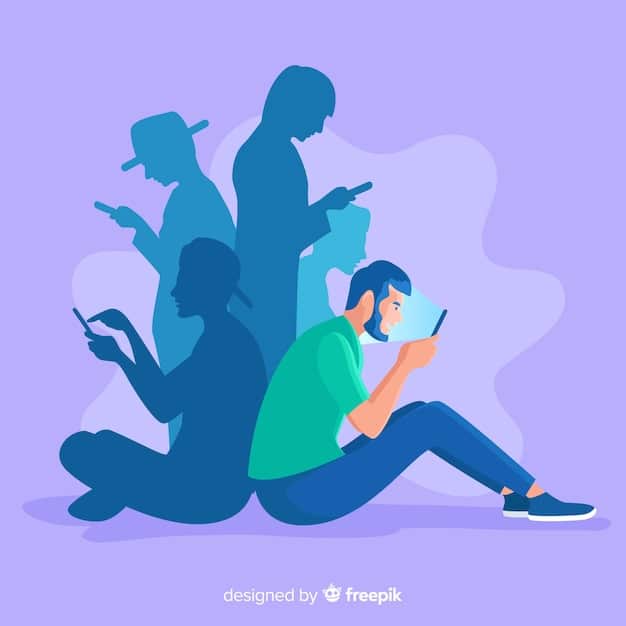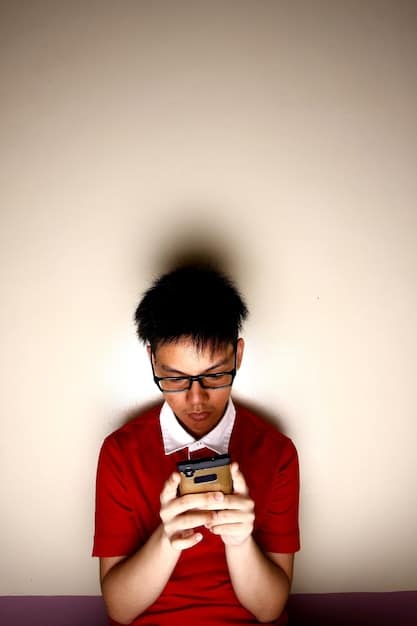Social Media’s Impact on Mental Health: Psychological Effects of Constant Connectivity

The constant engagement with social media platforms has profound psychological effects on individuals, influencing self-esteem, increasing anxiety and depression, and altering social comparisons and sleep patterns.
In an increasingly interconnected world, where digital platforms serve as primary conduits for communication, information, and entertainment, understanding The Impact of Social Media on Mental Health: What are the Psychological Effects of Constant Connectivity? has become paramount. This persistent connection, while offering undeniable benefits, also casts a long shadow over our psychological well-being, demanding a closer examination of its far-reaching consequences.
The double-edged sword: Social media’s pervasive presence
Social media has irrevocably reshaped our lives, transforming how we interact, consume information, and perceive ourselves. From connecting distant friends to facilitating global movements, its positive contributions are undeniable. However, the relentless scroll, the curated lives of others, and the constant pursuit of validation introduce complex challenges to our mental landscapes.
The sheer volume of information and social interaction available at our fingertips means individuals are constantly bombarded with stimuli. This constant exposure can lead to a state of hyper-awareness, where boundaries between online and offline realities blur, contributing to an always-on culture that rarely allows for true disengagement or introspection.
The illusion of connection versus genuine relationships
While social media promises to connect us, the quality of these connections often differs significantly from real-world interactions. Superficial likes and comments can sometimes replace deeper, more meaningful engagements, leading to a sense of isolation despite being digitally surrounded by others.
- Superficial interactions: Digital exchanges often lack the nuance and emotional depth of face-to-face conversations.
- Reduced real-world engagement: Excessive screen time can displace time spent on in-person activities and relationships.
- Perceived isolation: Despite vast online networks, individuals can feel more alone if digital connections don’t translate into genuine support.
The constant performance inherent in maintaining an online persona can also be mentally exhausting. Individuals may feel compelled to present an idealized version of themselves, creating a disconnect between their online and offline identities, which can fuel feelings of inauthenticity and anxiety.
Ultimately, the omnipresence of social media underscores the critical need to understand how we can leverage its benefits responsibly while mitigating its potential psychological tolls. Balancing digital engagement with real-world experiences is key to fostering healthier mental states in the digital age.
Erosion of self-esteem and body image
One of the most frequently cited psychological effects of constant connectivity via social media is its profound impact on self-esteem and body image. Platforms primarily driven by visual content, such as Instagram and TikTok, often showcase highly curated and idealized versions of reality. Users are constantly exposed to images of perceived perfection, from flawless skin and sculpted bodies to luxurious lifestyles and seemingly perfect relationships.
This relentless stream of idealized content can lead to unfavorable social comparisons. Individuals, particularly adolescents and young adults, often compare their own lives, appearances, and achievements to those presented online, creating a breeding ground for feelings of inadequacy, envy, and dissatisfaction. The gap between perceived online perfection and personal reality can be significant, contributing to a diminished sense of self-worth.
The ‘highlight reel’ effect and its consequences
The “highlight reel” effect refers to the tendency of users to post only the most positive, appealing, or successful aspects of their lives, omitting struggles, setbacks, or ordinary moments. While understandable, this curated presentation creates an unrealistic standard against which others measure themselves.
- Increased body dissatisfaction: Exposure to idealized body types often leads to negative self-perception and body image issues.
- Envy and resentment: Constantly seeing others’ perceived successes can foster feelings of envy and resentment towards peers.
- Lower self-worth: The inability to meet unrealistic online standards can significantly reduce an individual’s self-esteem.
This phenomenon is particularly damaging because it fosters a false belief that everyone else’s life is inherently better or more glamorous. The constant pursuit of online validation through likes and comments further exacerbates this issue. When posts don’t receive the anticipated level of engagement, individuals may interpret it as a personal failing or a lack of acceptance, deeply affecting their self-perception.
Moreover, the ease with which photo editing tools and filters can alter appearances contributes to this distorted reality. Individuals might feel pressured to use these tools themselves, leading to a cycle of dissatisfaction with their authentic selves. Recognizing and challenging these unrealistic portrayals is crucial for maintaining a healthy self-image in the digital era.
Anxiety, depression, and FOMO (Fear of Missing Out)
The constant digital tether supplied by social media profoundly influences mental health, frequently escalating feelings of anxiety and depression. The incessant notifications, the pressure to respond immediately, and the fear of being excluded contribute to a heightened state of mental unrest. Individuals often find themselves trapped in a cycle of checking their devices compulsively, driven by an underlying anxiety that they might miss something important or be left out of social circles.
This anxiety is often encapsulated by the phenomenon known as FOMO, or the “Fear of Missing Out.” Social media platforms are designed to showcase collective experiences, often presenting a curated view of others’ exciting lives, events, and accomplishments. When individuals scroll through these feeds, they are constantly reminded of what their friends or acquaintances are doing without them. This can trigger feelings of envy, inadequacy, and loneliness, even if the perceived “missing out” is based on an idealized, rather than a genuine, depiction of reality.
The cycle of negative comparison and rumination
FOMO is not just about missing an event; it’s about the perceived loss of a social experience, an opportunity for connection, or a chance to belong. This pervasive fear can lead to obsessive social media use, as users try to keep up with every update, often sacrificing sleep and other critical activities for their well-being.
- Increased anxiety: Constant vigilance to social media feeds can elevate general anxiety levels.
- Symptoms of depression: Feelings of isolation and inadequacy stemming from FOMO can contribute to depressive symptoms.
- Sleep disturbances: Late-night social media use interrupts natural sleep cycles, worsening mental health.

For some, this continuous exposure to others’ seemingly perfect lives can lead to a deeper sense of worthlessness and hopelessness. The brain’s reward system, activated by likes and positive comments, can also create an addictive loop, making it difficult to disengage even when the experience is predominantly negative. The more a person attempts to alleviate FOMO by engaging with social media, the more they might expose themselves to the very content that triggers these negative emotions, perpetuating a destructive cycle.
Moreover, the blurring lines between online and offline presence mean that individuals might constantly feel the need to be “on call,” ready to engage or respond. This lack of mental breaks can lead to chronic stress and burnout, further exacerbating underlying predispositions to anxiety and depression. Disconnecting, even for short periods, becomes a challenge, reinforcing the vicious cycle of constant connectivity and mental distress.
The impact on sleep patterns and academic/professional performance
The Impact of Social Media on Mental Health: What are the Psychological Effects of Constant Connectivity? extends significantly to sleep patterns and, consequently, academic or professional performance. The ubiquitous nature of smartphones and tablets means that social media is often the last thing people engage with before bed and the first thing they check upon waking. This consistent exposure, particularly at night, profoundly disrupts natural sleep cycles.
The blue light emitted from digital screens is a primary culprit. Blue light suppresses the production of melatonin, a hormone crucial for regulating sleep-wake cycles. By delaying melatonin release, social media use before bedtime makes it harder to fall asleep, contributes to lighter sleep, and frequently leads to fragmented rest. The alluring pull of notifications, new posts, and trending topics further exacerbates this issue, tempting users to stay awake longer than intended.
Sleep deprivation and its ripple effects
The cumulative effect of poor sleep hygiene is sleep deprivation, which has cascading negative impacts on various aspects of life. Chronic lack of sleep impairs cognitive functions, including concentration, memory, and problem-solving abilities. This directly translates into diminished academic achievement for students and reduced productivity and efficiency for working professionals.
- Reduced cognitive function: Sleep deprivation impairs concentration, attention span, and memory recall.
- Lower academic grades: Students experience difficulty focusing during classes and studying effectively.
- Decreased work productivity: Employees may struggle with tasks requiring sustained attention and critical thinking.
Beyond cognitive impairments, sleep deprivation contributes to irritability, mood swings, and a decreased ability to cope with stress. These emotional disturbances can strain interpersonal relationships and further contribute to a decline in overall mental well-being, creating a detrimental feedback loop. The exhaustion from insufficient sleep can make individuals more susceptible to feelings of anxiety and depression, amplifying the psychological toll of social media.
For many, the distinction between “winding down” and engaging with stimulating online content becomes blurred. What starts as a brief check of notifications can quickly turn into hours of scrolling, driven by algorithms designed to maximize engagement. Establishing clear boundaries around technology use, especially in the hours leading up to bedtime, is essential for protecting sleep quality and, by extension, ensuring optimal mental and functional performance.
Cyberbullying and online harassment: A digital shadow
The anonymity and perceived distance offered by social media platforms can unfortunately embolden individuals to engage in behaviors they might never consider in face-to-face interactions. This phenomenon gives rise to cyberbullying and online harassment, significantly contributing to negative psychological effects. Unlike traditional bullying, cyberbullying can be relentless, occurring 24/7, and its reach is often global, making escape incredibly difficult for victims.
Victims of cyberbullying frequently experience severe emotional distress, including intense feelings of humiliation, anger, helplessness, and fear. The public nature of online attacks means that once content is posted, it can spread rapidly and remain accessible indefinitely, creating a permanent digital record of the abuse. This persistence contributes to chronic stress and anxiety, as victims may constantly worry about new attacks or the re-emergence of past incidents.
The psychological scars of digital aggression
The impact of cyberbullying extends beyond immediate emotional reactions. It can severely erode a victim’s self-esteem and sense of security. Because attacks often target personal characteristics, appearance, or social standing, victims may internalize the negative messages, leading to self-doubt and self-blame. The feeling of being unable to escape the torment, even within their own homes, can be particularly isolating and terrifying.
- Increased risk of depression and anxiety: Victims often show symptoms consistent with clinical depression and anxiety disorders.
- Social withdrawal: Individuals may become withdrawn from both online and offline social interactions due to fear or shame.
- Suicidal ideation: In severe cases, cyberbullying has been tragically linked to suicidal thoughts and attempts.
For public figures, influencers, or individuals who unexpectedly go viral, online harassment can escalate into mob mentality, where thousands or millions of users participate in shaming or ridiculing. This collective aggression amplifies the feeling of being overwhelmed and targeted, making it incredibly difficult for the individual to recover their sense of peace or safety. The line between constructive criticism and malicious targeting often blurs in these scenarios.

Moreover, platforms sometimes struggle to adequately moderate content and protect users, leaving victims feeling unsupported and unprotected. This lack of effective recourse can compound their distress. Recognizing the severity of cyberbullying and implementing robust strategies for prevention, intervention, and support is vital for creating safer online environments and safeguarding the mental health of all users.
Digital well-being: Strategies for a healthier relationship with social media
Given the significant psychological effects of constant connectivity, adopting strategies for fostering digital well-being is not merely advisable but essential. A healthy relationship with social media does not necessarily mean total abstinence; rather, it involves intentional and mindful engagement, recognizing both the benefits and the potential pitfalls of these powerful platforms.
One fundamental strategy is to cultivate greater self-awareness regarding one’s social media habits. This involves tracking usage time, observing emotional responses to different types of content, and identifying triggers that lead to excessive or negative engagement. Understanding these patterns is the first step toward making conscious changes.
Practical steps for mindful social media use
Implementing practical boundaries around social media use can significantly improve mental health. This might include setting specific times for checking feeds, designating ‘no-phone zones’ in the home, or observing digital detox periods.
- Set time limits: Utilize app-limit features or external timers to regulate daily social media consumption.
- Curate your feed: Unfollow accounts that trigger negative emotions or foster unhealthy comparisons. Follow those that inspire, educate, or entertain positively.
- Establish ‘no-phone zones’: Designate areas like the bedroom or dining table as phone-free zones to encourage real-world interaction.
- Practice digital detoxes: Periodically disconnect entirely from social media for a few hours, days, or even weeks.
Beyond limiting time, it is crucial to be deliberate about the content consumed. Users have the power to curate their feeds, unfollowing accounts that promote unrealistic ideals or provoke negative feelings, and actively seeking out content that is uplifting, informative, or genuinely inspiring. Engaging with diverse perspectives and voices can also broaden one’s understanding without succumbing to the echo chambers that often characterize online interactions.
Promoting real-world connections remains vital. Prioritizing face-to-face interactions, engaging in hobbies, and pursuing activities outside the digital realm can provide a sense of fulfillment and belonging that superficial online interactions often fail to deliver. Ultimately, achieving digital well-being is about reasserting control over our digital lives, ensuring that social media serves as a tool for connection and empowerment, rather than a source of distress.
| Key Effect | Brief Description |
|---|---|
| 😔 Self-Esteem Erosion | Constant exposure to idealized lives fuels negative social comparisons, diminishing self-worth and propagating body image issues. |
| 😟 Anxiety & FOMO | Fear of Missing Out (FOMO) and perpetual connection elevate anxiety levels, contributing to a constant state of mental unrest. |
| 😴 Sleep Disruption | Blue light exposure and late-night scrolling disrupt melatonin production, leading to sleep deprivation and impaired cognitive function. |
| зло Cyberbullying | Anonymity on platforms can foster harassment, causing severe emotional distress, humiliation, and increased risk of depression. |
Frequently Asked Questions
▼
Social media often leads to social comparison, where individuals compare their lives to the curated, idealized versions presented online. This can result in feelings of inadequacy, envy, and lower self-worth, particularly when users don’t receive the desired validation.
▼
FOMO, or Fear of Missing Out, is the anxiety that an exciting or interesting event may be happening elsewhere, often fueled by social media posts. Constantly seeing others’ activities can create feelings of exclusion, leading to increased anxiety and compulsive checking of feeds.
▼
Yes, excessive social media use, especially before bed, significantly impacts sleep. The blue light emitted by screens suppresses melatonin production, making it harder to fall asleep. Engaging with stimulating content also keeps the brain active, leading to poor sleep quality and quantity.
▼
Cyberbullying differs because it can occur 24/7, reaching a wide audience quickly, and leaving a permanent digital record. The perceived anonymity of online platforms can embolden bullies, while victims often feel amplified distress due to the public nature and persistence of the attacks.
▼
Strategies include setting daily time limits for social media, curating your feed by unfollowing negative accounts, establishing ‘no-phone’ zones (e.g., bedrooms), and regularly taking digital detox breaks. Prioritizing real-world interactions and hobbies also helps balance digital engagement.
Conclusion
The intricate relationship between social media and mental health is undeniable, with constant connectivity presenting a complex array of psychological effects. From the erosion of self-esteem through idealized comparisons to the pervasive anxiety fueled by FOMO and the detrimental impact on sleep, the digital world demands our critical attention. While social media offers avenues for connection and information, its unchecked use can lead to profound distress, exacerbated by issues like cyberbullying. Recognizing these interwoven challenges is the first step toward fostering a healthier digital ecosystem. Embracing mindful use, setting firm boundaries, and prioritizing real-world engagement are not just suggestions but essential strategies for navigating the mental health landscape of our hyper-connected age, ultimately allowing us to harness technology’s benefits without sacrificing our well-being.





